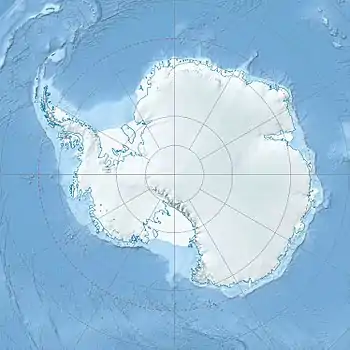Beardmore Glacier
The Beardmore Glacier in Antarctica is one of the largest valley glaciers in the world, being 200 km (125 mi) long and having a width of 40 km (25 mi).[1] It descends about 2,200 m (7,200 ft)[1] from the Antarctic Plateau to the Ross Ice Shelf and is bordered by the Commonwealth Range of the Queen Maud Mountains on the eastern side and the Queen Alexandra Range of the Central Transantarctic Mountains on the western. [2]
| Beardmore Glacier | |
|---|---|
 Location of the Beardmore Glacier in Antarctica | |
| Type | Valley glacier |
| Location | Queen Maud Mountains |
| Coordinates | 83°45′S 171°0′E |
| Length | 200 km (125 mi) |
| Width | 40 km (25 mi) |
| Thickness | unknown |
| Terminus | Ross Ice Shelf |
| Status | unknown |
The glacier is one of the main passages through the Transantarctic Mountains to the great polar plateau beyond, and was one of the early routes to the South Pole despite its steep upward incline.
The glacier was discovered and climbed by Ernest Shackleton during his Nimrod Expedition of 1908. Although Shackleton turned back at latitude 88° 23' S, just 97.5 nautical miles (180.6 km; 112.2 mi) from the South Pole, he established the first proven route towards the pole and, in doing so, became the first person to set foot upon the polar plateau. In 1911–1912, Captain Scott and his Terra Nova Expedition team reached the South Pole by similarly climbing the Beardmore. However, they reached the pole a month after Roald Amundsen and his team, who had chosen a route up the previously unknown Axel Heiberg Glacier. It was on the way back to the Nova expedition's base camp after they left the South Pole that Edgar Evans, one of the members of Scott's chosen team to go on to the final trek to the South Pole, died around the foot of Beardmore Glacier on February 17, 1912.
Beardmore Glacier was named by Shackleton after Sir William Beardmore, a Scottish industrialist and expedition sponsor.[2] However, Ranulph Fiennes writes that Shackleton had previously told Beardmore's wife, Elspeth, that he would name a glacier after her and it is possible that is what Shackleton actually did.[3]
In 2016, the first beetle fossils, in the form of wing-cases (elytra) of the ground beetle Antarctotrechus, around 14 to 20 million years old, were found in sediments adjacent to the glacier.[4][5]
References
- "Beardmore Glacier". www.britannica.com. Encyclopædia Britannica, Inc. Retrieved 10 January 2014.
- "Beardmore Glacier". Geographic Names Information System. United States Geological Survey, United States Department of the Interior. Retrieved 10 January 2014.
- Fiennes, Ranulph (2021). Shackleton: a biography. Michael Joseph. p. 201. ISBN 978-0-241-35671-5.
- "Rare Antarctic beetle find delights". BBC News. 29 November 2016. Archived from the original on 30 November 2016. Retrieved 29 November 2016.
- Barrat, John (1 December 2016). "One cold bug: Fossil beetle discovered in Antarctica". Smithsonian Insider. Smithsonian Institution. Archived from the original on 11 June 2019. Retrieved 13 July 2019.
![]() This article incorporates public domain material from "Beardmore Glacier". Geographic Names Information System. United States Geological Survey.
This article incorporates public domain material from "Beardmore Glacier". Geographic Names Information System. United States Geological Survey.